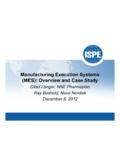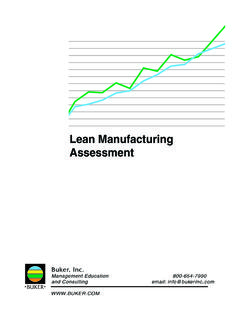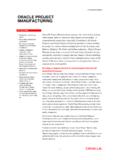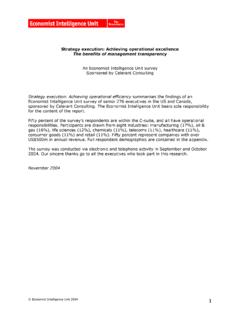Transcription of White Paper 7 Ways Shop Floor Execution (SFX) Systems …
1 What is Lean manufacturing ? For an idea that has been around since 1991, lean manufacturing still garners plenty of attention. The term lean manufacturing was first introduced in the book The Machine That Changed the World by Womack, Jones and Roos. This book was based on a five-year, $5 million study of the automobile industry; specifically, the manufacturing Systems used by the Toyota Motor Corporation. Despite how often we hear about learn manufacturing these days, the term is still ambiguous and, often, difficult to explain. Lean represents a high-level manufacturing philosophy that often encompasses myriad trends and programs, including common-sense manufacturing practices that have been around for years. A company that has adopted lean manufacturing may, for example, use Kanbans, demand flow and cellular manufacturing in their plant. Setup reduction, JIT, inventory reduction, waste reduction, product quality, real-time information and improved shop Floor layouts are also all components of a lean manufacturing initiative.
2 Lean manufacturing today is similar to Total Quality Management (TQM) programs of the 80 s and 90 s. To cynics, lean is nothing more than a new slew of buzzwords, seminars and revenue for consultants. To the more charitable, lean is years of accumulated best practices under a single umbrella to help today s manufacturers improve operations. In the simplest terms, lean is a philosophy designed to maximize customer value while minimizing waste , according to the Lean Enterprise Institute, a lean manufacturing think tank. In theory, lean creates reduced defects, increased uptime and streamlined operations, all of which can create desirable cost savings and cycle-time reduction. To realistically achieve these goals, however, an operation would need timely, reliable information from multiple areas of the shop Floor to identify areas of waste, improve decision making, improve the ability to respond to customer needs and to ensure defect-free output. When you eliminate waste and non-value added activities, you hope to reduce costs, lead times and inventory requirements.
3 Lean Systems emphasize the use of preventive maintenance, quality improvement programs, pull Systems and flexible work forces (and production facilities) to increase overall efficiency. According to research by the Massachusetts Institute of Technology s Laboratory for manufacturing and Productivity, lean Systems also encourage designing and managing production processes that reduce waste. In fact, Lean production is aimed at the elimination of waste in every area of production. Its goal is to incorporate less human effort, less inventory, less time to develop products, and less space, to become highly responsive to customer demand while producing top quality products in the most efficient and economical manner possible. Lean is a Journey, not a Destination No matter how long you have been working on lean techniques, you will always be in the process of becoming Lean. Lean is a continuum which requires a consistent effort to monitor progress against measured goals. Many North American manufacturers, eager for instant results, try to steal the "quick fix" parts of a Lean methodology.
4 They awkwardly force the fixes into existing plants in attempted attacks on lean s enemy waste. Often called the "seven deadly wastes of manufacturing " or the "seven sins of manufacturing ", the MIT manufacturing and productivity lab describes waste as consisting of the following seven aspects: White Paper 7 Ways Shop Floor Execution (SFX) Systems Help with Lean Casco Development, Inc. 2 Portland Fish Pier Portland, ME 04102 Phone: Fax: 1. Overproduction. The production of more goods than demanded or the production of goods before they are needed. 2. Inventory or work-in-process (WIP). Materials that are in limbo between operations due to large lot production or processes with long cycle times. 3. Transportation. The moving of parts back and forth from production to inventory or from process-to-process. 4. Over-processing. Unnecessary production steps. In other words, doing more work than is necessary to complete a process. 5. Motion. The movements of workers, machines, and parts more than needed.
5 6. Waiting. Time during which a process cannot be started or a product cannot be shipped because another process is still being completed. 7. Making defective parts. Creating any parts that cannot be sold as-is or that must be reworked. You May Have Tried Lean with Failed In the 1980s, most factories implemented some type of manufacturing Resource Planning (MRPII) system to improve operational and financial planning. These Systems worked wonders for planning but managers could not keep them accurate because they lacked real-time feedback from the factory. Shop Floor data collection has helped solve this problem somewhat by providing a path to quickly and accurately enter production feedback and keep the MRPII system up to date. Over time, MRPII evolved into Enterprise Resource Planning (ERP), a system that grew to incorporate most of the departments within a company. ERP system functionality provides strong capabilities in costing, inventory control and transaction processing to handle key business Systems .
6 Unfortunately, ERP Systems usually cannot drill down to the shop Floor to manage individual orders or individual workstations in real time. And without real-time feedback from production, managers are forced to use standard lead times for costing rather than actual times. Manufacturers often find that lead times at each work center may be much higher than needed, resulting in higher work-in-process, inaccurate delivery dates and waste, according to Why ERP is not Enough, a whitepaper by RSS Solutions. Manufacturers need Systems that provide real-time feedback on employees, orders and machines. Conventional enterprise Systems don't support managers and operators in their daily production activities. Without a specialized tool to manage the detailed operations on the shop Floor , manufacturers will have difficulty applying lean principals; you can t improve something you can t measure. ERP vendors have historically offered limited shop Floor control and feedback functionality.
7 Most point customers to expert partners to provide this missing but essential functionality. What is SFX? A Bridge to ERP and More Designed to complement your ERP system , Shop Floor Execution (SFX) Systems provide the missing link. A new category of software, SFX automates and streamlines factory operations by combining three popular applications around a core of shop Floor data collection: Labor management (time and attendance) Machine utilization Paperless dispatching This Execution -oriented combination provides the essential tools for real-time production process management. Unlike manufacturing Execution Systems (MES) that are costly and time consuming to implement, SFX Systems Casco Development, Inc. 2 Portland Fish Pier Portland, ME 04102 Phone: Fax: 7 Ways Shop Floor Execution (SFX) Systems Help with Lean offer a targeted approach designed to generate immediate results. How can SFX Help with Lean Initiatives? Sometimes, when managers begin to implement a lean initiative, the first thing they want to reduce or eliminate is data collection.
8 We would argue that you can keep your data collection and still be lean. You can t measure what you don t track, and SFX Systems are designed to make the measurement process easy and painless. Like TQM, lean programs require data to feed decisions. You need to know your starting time and costs to any see improvement in these areas. For example: If you want to reduce set-up times, you must know how long set-ups take now If you want to eliminate scrap, you must know what the leading causes for scrap are If you want to improve throughput, you must know how long it takes for orders to move through the shop. Beyond benchmarking and traditional labor collection, SFX can help eliminate waste and increase productivity. Let s look at the seven types of waste and how SFX can minimize or eliminate them. 1. Over-production Factory operators are your key resource, and they need proper management to ensure their work is essential and timely. When operators arrive at work, they should have access to a dispatch list or ready-list of assignments with no option for deviation.
9 When left unguided, operators may work on jobs they like best and may run out of materials on a given line because it is the easy thing to do. The result is a surplus of unnecessary inventory. A dispatch list provides each operator with a clear view of what to do next . As the dispatch list is generated from the production planner s most recent schedule adjustments, the dispatch list will always reflect the plant s current priorities. A dispatch list also ensures that operators spend their time doing only what is required by the system to fulfill existing orders. It provides operators with a view of the entire routing and how their specific tasks fit into the big picture of larger operations. This visibility empowers employees so they can realize full impact of their contribution. Operators take their assignments from touch screens that are continually updated with the most current schedule revisions. In addition to managing what tasks the operators are working on, an SFX system can also prevent operators from completing too many parts.
10 SFX Systems are tightly integrated with your ERP system and know the precise quantities required for each production order. When an operator begins a job, he is reminded of the total quantity required. When he completes the job, real-time validation of order number, step, and quantity will prevent him from over-reporting by showing a warning message. If he ignores the warning, he must select from a list of appropriate reason codes. Over-reporting can be flagged as an exception for Supervisors to review and can even show up on employee report cards for performance evaluation. 2. Inventory or Work-in-Process (WIP) Material caught between operations due to large lot production or processes with long cycle times must often wait until the entire lot is completed. This can increase already lengthy cycle times and take up precious Floor space. SFX Systems can help in a number of ways. As soon as quantities are completed at one step, they are immediately available and ready at the next step.






